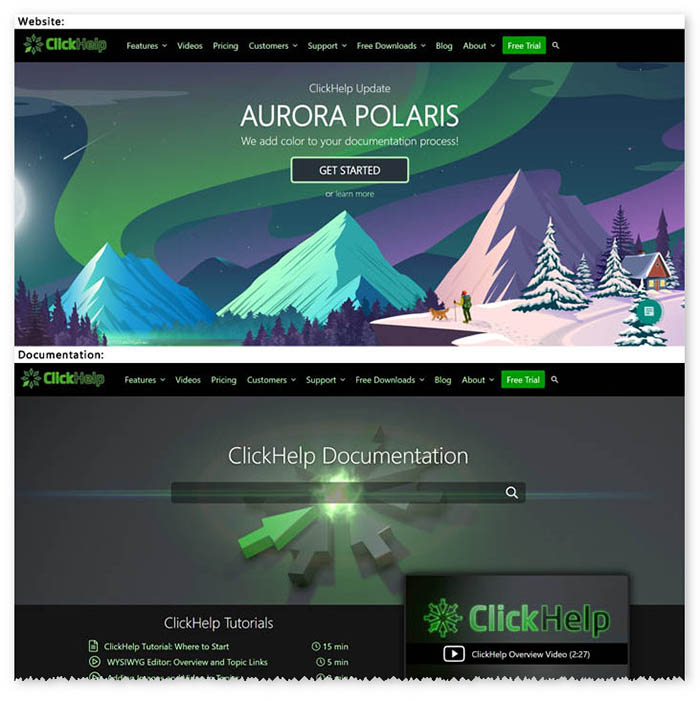
Online documentation was a very logical next step for technical writing. The Internet has become so easily accessible that looking up something online seems like a natural part of our lives. So, storing documentation online is not only a matter of convenience; by now, it has become common sense.
Help authoring tools like ClickHelp allow creating online documentation portals for your technical docs. Which basically means having all technical documents available in one place.
And, still, situations exist when readers can’t reach online documentation. For example, when the readers work in an isolated network, or when a person simply doesn’t have an Internet connection at the moment. One of the common solutions here is providing docs in the PDF or CHM (for Windows) formats, which can be easily done with ClickHelp, as well. But it still isn’t a silver bullet – PDF requires software, and, besides, looking for answers there can be very tough since it is a single document; while CHM works only for Windows…
Luckily, a better solution exists – Web Help. This format unites the lightweight nature of online browser-based documentation and the possibility of reading the docs without the Internet connection.
What is Web Help?
Web Help is a documentation format that can be delivered both online and through locally stored HTML files (plus resource files). In the second case, you get a set of files that you can store in a local network or just on a hard drive, and open them in a web browser without the need to have an Internet connection to read a browser-based user guide.
Web Help can look different in terms of style and navigation. In ClickHelp, a variety of branding options are available for Web Help outputs like branding CSS styles and customizing the files Web Help package contains to make it look more similar to your website. Check out how our Web Help documentation has the same menu as our website:

Web Help Benefits
Why is Web Help a good solution? Well, there are several reasons.
- Web Help is browser-based. This is reason one. People are used to browsers. A lot of SaaS products can be accessed right from a browser and do not require any software installed.
- Reason two would be – Web Help can be delivered as part of your application installation package so it will be automatically copied to the computer where your software is getting installed. This means that your desktop tool’s UI can contain context links leading straight to Web Help, and the respective help topics will be opened in a web browser.
- Web Help is a great solution for companies with strict security policies. In some companies, technical documentation has to be hosted together with their product. Web Help works great for such cases – you can host the user guides on the same infrastructure that you use for your SaaS solution.
- Convenient navigation. Web Help can include search, an index, breadcrumbs – all the common and familiar navigation tools. This will help your readers use the documentation easier.
- Web Help can contain interactive elements. You can add popups, boxes, videos, etc. to your Web Help. This can greatly enhance the user experience.
To sum it up a little – Web Help allows creating a fully-functional browser-based documentation portal without any Internet connection required.
Web Help Shortcomings
So far, Web Help looks very promising. But are there any drawbacks? Any technical solution has its field of applicability where it works best, and the Web Help technology also does. But, we believe that those shortcomings are more so minor inconveniences than serious flaws.
- Extra steps are required to set up Web Help. In general case, when dealing with online help in ClickHelp, you just need to create a documentation project and publish it online. To get a Web Help file set, one needs to perform some more actions – export docs as Web Help and host them somewhere. This takes a bit more time than just using an online documentation portal.
- Every Web Help is a separate user manual. That is, if you want to create a homepage for all your docs, you will have to manually add and update all the links to web help files there. When using an online documentation portal solution, this type of Home page is provided by the platform itself, and the user guide links are auto-updated when you publish more manuals.
- Analytics availability. If you are working in an air gap network, for example, then, getting analytical data is a no go, of course – there is no connection to the analytics endpoint or to Google Analytics. On the other hand, if we are talking about just using your own hosting for the Web Help docs instead of hosting them in a portal, then you get all the stats. Google Analytics smoothly integrates into Web Help created in ClickHelp.
- Setting up access restrictions. When you are hosting user manuals in a ClickHelp portal, it is easy to configure access options, create reader accounts, etc. But, in case you are hosting Web Help yourself, you will have to manage everything on your own: access, user registration, permissions.

Conclusion
Web Help can be a nice solution for readers in isolated networks or in case someone needs to access a user manual offline. Web Help is more universal than CHM as the latter works for Windows users only, and more convenient than PDF due to advanced navigation and interactive elements.
Web Help’s drawbacks are connected with its maintenance – if you are hosting Web Help yourself, then you’ll have to manually set up and maintain a doc portal and manage permissions and access. All in all, we think that Web Help is a good approach to offline user manuals. And ClickHelp allows you to have both an online version hosted in your portal, and an offline version shipped with your product in the Web Help format.
Good luck with your technical writing!
ClickHelp Team
Author, host and deliver documentation across platforms and devices
